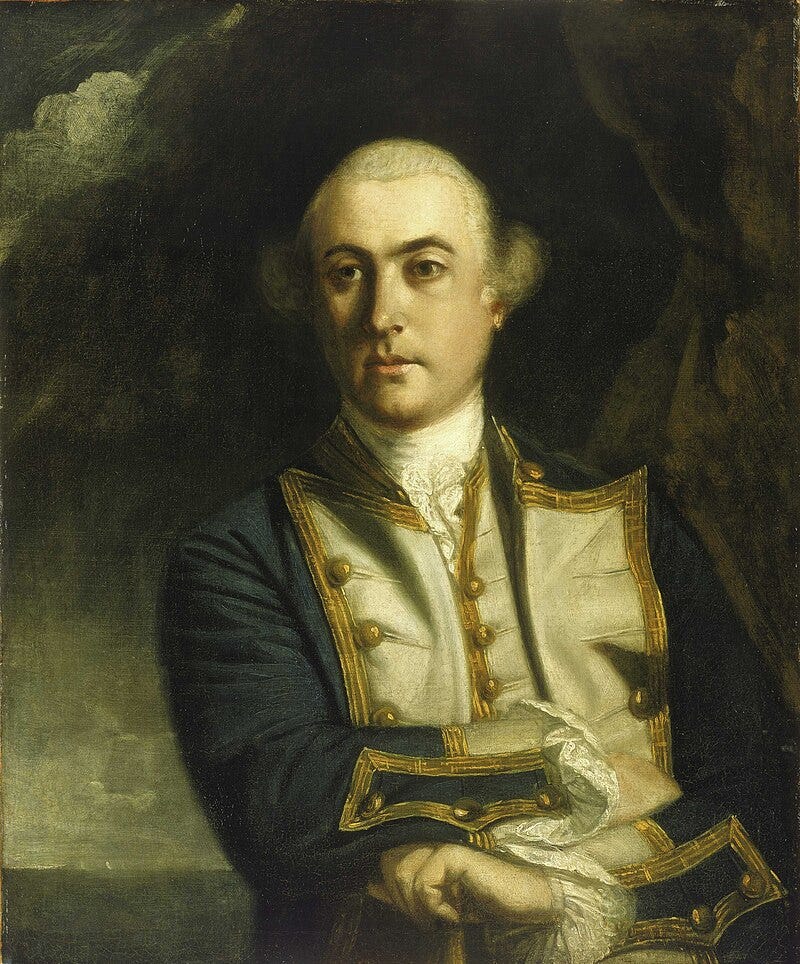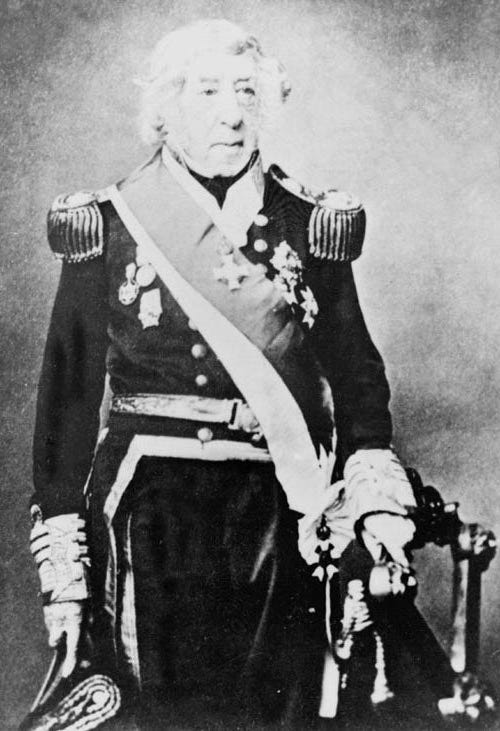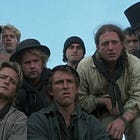Master and Commander - Author's Note (2)
Characters
Continuing from last week’s discussion of the author’s note, here’s O’Brian:
My point is that the admirable men of those times, the Cochranes, Byrons, Falconers, Seymours, Boscawens and the many less famous sailors from whom I have in some degree compounded my characters, are best described in their own splendid actions rather than in imaginary contests; that authenticity is a jewel; and that the echo of their words has an abiding value.
Notice how explicit O’Brian is in celebrating the Royal Navy of the Napoleonic Era. The men are “admirable,” their actions are “splendid,” their accomplishments are so “improbable [that] reality outruns fiction.” That’s not surprising. One of the reasons the books are popular is that O’Brian celebrates a famous era in British naval history. Give the people what they want.
On the other hand, O’Brian the novelist knows better than to paint his characters as two-dimensional legendary heroes—you can’t keep readers engaged without human flaws and idiosyncrasies.
That’s why the passage above is so interesting. It’s common to associate Aubrey with Cochrane because the cruise of Cochrane’s Speedy clearly inspired Aubrey’s cruise in Sophie (more on that to come) and because O’Brian explicitly tells us that Cochrane is an inspiration before the book even starts. I wonder, though, how many curious readers have managed to look at the other names on the list. Well, that’s what I’m here for:
Byrons, Falconers, Seymours, Boscawens
I’ll get to Cochrane in a minute, but let’s look at the other names first.
Byron is not quite that Byron, but close. He’s Lord Byron the poet’s grandfather, Vice-Admiral John “Foul-Weather Jack” Byron. By 1969, when he published Master and Commander, O’Brian knew Byron well. He had used him as the main character in his 1959 book The Unknown Shore, which followed the tragic story of HMS Wager on Anson’s voyage. That voyage was recently the subject of a best-seller, as I’m sure many of you know. Byron was a midshipman on the voyage and survived to write a famous narrative of the shipwreck, which his grandson used as his source for the shipwreck in his epic poem Don Juan.
Falconer might be the Hon. George Falconer, but he doesn’t even have a Wikipedia page. He was a nondescript post-captain in the 1760s and 1770s. Or, Falconer might be William Falconer, who wrote a poem about merchant seafaring in 1762 called The Shipwreck and then went on to join the navy. There’s a chance O’Brian meant one or more members of the Faulknor family, which produced nine naval officers across the eighteenth century. The most famous, Robert Faulknor, died in action while commanding a frigate—O’Brian’s kind of guy. But Faulknor ≠ Falconer—maybe I’m missing some famous Falconer? I’m a little confused, to be honest.
Seymour is probably Sir Michael Seymour, 1st Baronet. There’s another Seymour, Lord Hugh Seymour, who was an admiral in the French Revolutionary Wars, but Sir Michael is more plausible. He won his baronetcy as a captain by defeating two larger French ships, one in 1808 and one in 1809, while commanding the frigate HMS Amethyst—exactly the kinds of actions that O’Brian wanted to draw from for his action scenes.
Boscawen was a famous captain and admiral of the 1740s and 1750s. He captured the fortress of Louisbourg in 1758 and won a great fleet victory off Lagos, Portugal, in 1759 as part of Britain’s “year of victories” in the Seven Years War. Nicknamed “Old Dreadnought,” he was determined and courageous but also known to care deeply for his men—in other words, a good model for Aubrey.
I wish I could make the case that “actually Aubrey = Boscawen,” but O’Brian won’t let me. He put someone else’s name first:
Cochranes
Ugh, where to start.1 I had to deal with Thomas, Lord Cochrane, in The Horrible Peace, and here’s what I came up with:
Thomas Cochrane had been a dashing frigate captain during the wars whose naval career had come to a standstill after he had accused Admiral Lord Gambier of failing to follow-up on an opportunity to destroy the French fleet at anchor off Rochefort. It was neither the first nor the last time he clashed with his superiors. After being found guilty of stock exchange fraud in 1814, Cochrane was fined, imprisoned, stripped of his knighthood, and struck off the navy list. That freed him to accept, in 1817, the offer of the Chilean government to organize and command their fleet in the war against the Spanish. Though he negotiated an astonishing salary of £2,000 per year (about three times Gambier’s salary as Commander-in-Chief of the Channel Fleet), he was soon bickering with San Martín’s naval minister over issues of prize money.2
Those who know O’Brian’s series well will recognize the plot of The Reverse of the Medal in the stock exchange fraud. But O’Brian was obviously drawing on Cochrane from the start.
And that’s, well, not problematic, exactly, but … complicated. No officer causes otherwise-sane historians to go completely bonkers like Cochrane. The Chileans still see him as a national hero, which is fair enough given what he did for their navy and their independence.3 The problem is everyone else. Despite what the several hagiographies that still regularly turn up on Barnes & Noble bookshelves say, in fact, Cochrane was a thorn in the side of every commanding officer he ever had; he was aggressive to a fault; he was clever; he was selfish; he was unpredictable. A handful of his fellow officers worshipped him; most regarded him with deep suspicion.
Cochrane wrote a lively autobiography at the end of his long life, and I can’t do better than N.A.M. Rodger’s summary of it: “A mendacious work of self-justification, to be used with extreme caution. Unfortunately almost all his biographers (to say nothing of Marryat, Forester, and O’Brian) have adopted it uncritically.”4
Cochrane the brave captain of Speedy? Sure. Cochrane the innocent victim of someone else’s fraud? Doubtful. As far as inspirations go, Cochrane’s life is full of color, but it can be difficult to see through the nonsense.
Back to the Setting
Cochrane aside, my takeaway from this exercise is how spread-out O’Brian’s list is. As a historian, I get some whiplash when reading the names in the order that he lists them. Byron and Boscawen belong to the mid-eighteenth-century navy; Cochrane and Seymour served well into the nineteenth century. Cochrane in fact died ninety-nine years after Boscawen. But what O’Brian wanted was inspiration for building his world, not a narrow study of the navy in a particular decade. Ironically, what he ended up writing was twenty novels set in just over a decade: see my previous post about why the Napoleonic timeframe is misleading, linked below. Byron and Boscawen are more evidence that O’Brian was looking back into the middle of the eighteenth century.
Enough from me: next week, my dad will talk about “the reveal” in chapter one.
Cochranes really should be plural, though it’s clear that O’Brian drew most of his inspiration from Thomas, Lord Cochrane. Sir Alexander Cochrane was also a problematic naval officer, though! See Sam Cavell, “Abolition, the West India Colonies and the Troubling Case of Vice-Admiral Sir Alexander Cochrane, 1807–1823,” The Mariner's Mirror 107, no. 1 (2021): 23–39.
The Horrible Peace, 260.
He also helped the Brazilians, though I don’t get the sense they share the Chileans’ enthusiasm for Cochrane. The Chileans have almost always had a ship named Cochrane on active service; today the Almirante Cochrane is a Duke-class anti-submarine frigate, purchased from the Royal Navy in 2005.
Marryat is the nineteenth-century historical novelist Frederick Marryat, a veteran of the Napoleonic Wars. N.A.M. Rodger, The Command of the Ocean: A Naval History of Britain, 1649–1815 (New York: W.W. Norton, 2004), 794.





Thanks! Having read these books at a one a year pace and just finished "21", I am enjoying this commentary immensely. Love the stuff about changing naval culture and how Aubrey was sort of a "throwback" to an earlier era.
Here is a belated note responding to a point you made in a previous post. I forgot to send it then, but I’m taking the liberty of doing so now.
Regarding O’Brian’s brilliant mixture of reality and invention, I am reminded of the incident involving the goat in “Master and Commander.” I can very well believe that a sailor was punished severely for unnatural relations with livestock, but the brilliant description of how Dr. Maturin decided not to have any cream in his coffee could only come from the imagination of someone like Mr. O’Brian.